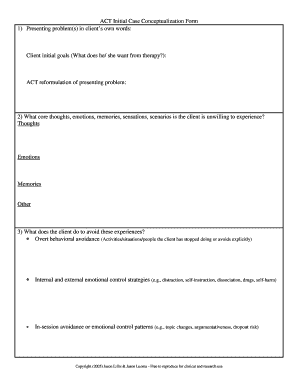
Get Case Conceptualization Template
How it works
-
Open form follow the instructions
-
Easily sign the form with your finger
-
Send filled & signed form or save
How to fill out the Case Conceptualization Template online
This guide provides clear and detailed instructions on how to effectively fill out the Case Conceptualization Template online. By following these steps, users can ensure they provide comprehensive information that supports therapeutic processes.
Follow the steps to complete the Case Conceptualization Template efficiently.
- Click ‘Get Form’ button to obtain the template and access it in your digital editor.
- Begin with the first section labeled 'Presenting problem(s) in client’s own words.' Here, record the client's description of their issues, taking care to use their language and perspective.
- Next, fill out the section titled 'Client initial goals.' Detail what the client seeks to achieve through therapy and what outcomes they desire.
- For the 'ACT reformulation of presenting problem,' provide a reformulated understanding of the client’s presenting issues based on Acceptance and Commitment Therapy principles.
- In the subsequent section, document the core thoughts, emotions, memories, sensations, or scenarios that the client is unwilling to experience. List these under the corresponding categories: thoughts, emotions, memories, and other.
- Address the client's avoidance strategies by detailing what actions they take to avoid these difficult experiences in the designated section. Include both behavioral avoidance and emotion control strategies.
- Next, in 'Relevant motivational factors,' describe how the client's avoidance behaviors impact their daily life, any sense of unworkability they experience, their clarity of values, and the therapeutic relationship.
- Identify and list any environmental barriers to change that may affect the client, detailing influences such as their social environment, financial situations, or negative contingencies.
- Explore the factors contributing to psychological inflexibility. Note behaviors such as excessive self-governance or a lack of awareness that may hinder the client’s progress.
- With all gathered information, determine which areas of Acceptance and Commitment Therapy may require emphasis in the treatment approach.
- Finally, summarize the client's strengths and outline the initial ACT treatment plan. This will guide future sessions and therapeutic focus.
- After completing the document, ensure to save your changes. You may also download, print, or share the completed form as needed.
Start filling out your Case Conceptualization Template online today.
Formatting a case conceptualization typically involves breaking down the information into clear sections, like background information, assessment, and intervention strategies. You may choose to use bullet points for clarity or headings for easy navigation. A Case Conceptualization Template can guide you in deciding how to present each section effectively. This organized format makes it easier for both you and your colleagues to understand the key elements of the case.
Industry-leading security and compliance
-
In businnes since 199725+ years providing professional legal documents.
-
Accredited businessGuarantees that a business meets BBB accreditation standards in the US and Canada.
-
Secured by BraintreeValidated Level 1 PCI DSS compliant payment gateway that accepts most major credit and debit card brands from across the globe.


